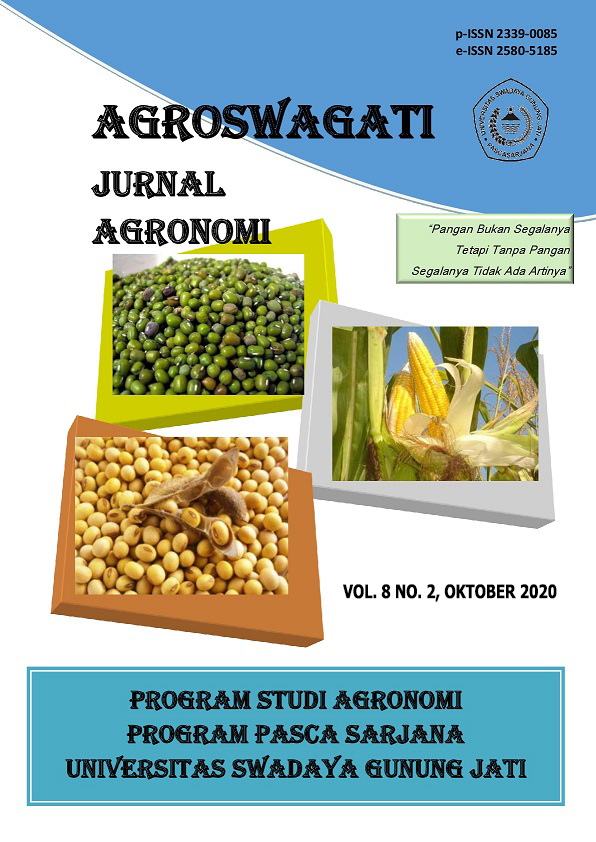RESPON PERTUMBUHAN DAN HASIL PADI (Oriza sativa L.) VARIETAS INPARI 42, CIHERANG DAN MEKONGGA TERHADAP BERBAGAI METODE TANAM JAJAR LEGOWO
DOI:
https://doi.org/10.33603/agroswagati.v8i2.4943Kata Kunci:
Varieties Rice, Legowo row planting method, Growth and YieldAbstrak
This study aims to determine: (1) The response to growth and yield of rice in Inpari 42, Ciherang and Mekongga varieties to various planting methods of Jajar Legowo, and (2) Varieties and planting methods of legowo row which have a good effect on rice growth and yield. The research was carried out in a rice field area belonging to the UPTD of the Food and Agriculture Security Service in Cirahayu Village, Luragung District, Kuningan Regency, from April to June 2020. The method used in this study was an experimental method, using a randomized block design (RBD), which consisted of 15 treatments of combination of rice varieties and the legowo row planting method and was repeated three times. To determine the effect of the treatments tested, analysis of variance was used through the F test, with further tests using Scott Knott's Cluster Test at the 5 percent real level. The results showed that: (1) The treatment of three rice varieties on various planting methods had significant effects on the growth and yield of rice plants. The 2 : 1 legowo row planting method on three rice varieties affected the plant height of harvested dry grain and milled dry grain per plot, while the 4 : 1 legowo row planting method in three rice varieties had an effect on the number of tillers per hill, the number of productive tillers per hill, leaf area index, number of panicles per clump, number of grains per panicle, number of filled grains per panicle, weight of 1000 grains of grain. The Ciherang variety has a good effect on the weight of 1000 grain grains, while the Inpari 42 variety has a good effect on the yield of dry grain harvested and the yield of milled dry grain per plot, and (2) the combination of Inpari 42 variety with the 2: 1 legowo row planting method gives good effect on yields of harvested dry unhulled rice and yields of milled dry unhulled rice per plot, which is 9.27 kg or equivalent to 10.30 tons of dry unhulled rice per hectare, and 7.81 kg of dry unhulled rice per plot or equivalent to 8.68 tons of unhulled rice dry milled oer acres.
Referensi
Agriansyah, N, 2014. Optimalisasi Pengelolaan Padi Sawah (Oryza sativa L.) pada Berbagai Varietas dan Sistem Tanam. Program Studi Agroteknologi, Jurusan Budidaya Pertanian, Unhas, Makassar.
Bima Satria, Erwin Masrul Harahap, dan Jamilah. 2017. Peningkatan Produkti-vitas Padi Sawah (Oryza sativa L.) Melalui Penerapan Beberapa Jarak Tanam dan Sistem Tanam. Jurnal Agroekoteknologi FP USU E-ISSN No. 2337- 6597 Vol.5 No 3, Juli 2017 (80): 629- 637.
Candra.V. Donggul, Iskandar M. Lapanjang dan Usman Made. 2017. Pertumbuhan dan hasil Tanaman Padi (Oryza sativa L). Pada Berbagai Pola Jajar Legowo dan Jarak Tanam. J. Agroland 24 (1): 27 - 35, April 2017.
Cepy dan W. Wayan. 2011. Pertumbuhan dan Hasil Tanaman Padi (Oryza sativa L.) di Media Vertisol dan Rntisol pada Berbagai Teknik Pengaturan Air dan Jenis Pupuk. Jurnal Crop Agro 4(2): 49-56.
Efendi, Halimursyadah, dan Simajuntak, H.R. 2012. Respon Pertumbuhan dan Produksi Plasma Nutfah Padi Lokal Aceh terhadap Sistem Budidaya Aerob. Jurnal Agrista. 16 (3) :114-121.
Gardner. Pearce and R.L Mitchell. 2001. Fisiologi Tanaman Budidaya. UI Press. Jakarta.
Hatta, M. 2012. Jarak Tanam Sistem Legowo Terhadap Pertumbuhan dan Hasil Beberapa Varietas Padi pada Metode SRI. Jurnal Agrista 18: 8793.
Husana. 2010. Pengaruh Penggunaan Jarak Tanam Terhadap Pertumbuhan dan Produksi Padi Sawah (Oryza sativa L.) Varietas IR 42 dengan Metode SRI (System of Rice Intensification). Jurnal. Jurusan Agroteknologi. Fakultas Pertanian. Universitas Riau.
Ikhwani, Gagad Restu Pratiwi, Eman Paturrohman, A.K. Makarim. 2013. Peningkatan Produktivitas Padi Melalui Jajar Legowo. Iptek Tanaman Pangan. Vol 8 No 2. 7279.
Kafisa, S., L. Mawarni, Rosmayati. 2016. Uji Perbedaan Sistem Jajar Legowo Terhadap Beberapa Varietas Padi (Oryza sativa L.) Pada Lahan Sawah Tadah Hujan. Jurnal Agroekoteknologi Vol.4. No.4, (618):2202 – 2211 e-ISSN No. 2337-6597.
Lakitan, B. 2011. Fisiologi Pertumbuhan dan Perkembangan Tanaman. Raja Grafindo Perkasa, Jakarta.
Muliasari, A. A dan Sugiyanta. 2009. Optimasi Jarak Tanam dan Umur Bibit pada Padi Sawah (Oryza sativa L.). Makalah Seminar Departemen Agronomi dan Hortikultura. IPB-Bogor.
Mulyassir. 2012. Efek Jarak Tanam, Umur dan Jumlah Bibit terhadap Hasil Padi Sawah (Oryza sativa L.) Jurnal Manajemen Sumberdaya Lahan, 01 (02) L 207-2012.
Putu Sri Wahyuni, Nyoman Srilaba dan Emy Alberthina Rumtily. 2012. Pengaruh Varietas dan Kepadatan Tanam terhadap Perumbuhan dan Hasil Padi (Oryza sativa L.) Pada Lahan Sawah Di Anturan. Jurna Penelitian. Fakultas Pertanian Universitas Panji Sakti Singaraja.
Sitohang. 2014. Evaluasi Pertumbuhan dan Produksi Beberapa Varietas Padi Gogo (Oryza sativa L.) pada Beberapa Jarak Tanam yang Berbeda. Jurnal Online Agroteknologi 2, 2337–6597.
Sirrapa, P.M. 2011. Kajian Perbaikan Teknologi Budidaya Padi melalui Penggunaan Varietas Unggul Dan Sistem Tanam Jajar Legowo Dalam Meningkatkan Produktivitas Padi Mendukung Swasembada Pangan. Jurnal Budidaya Pertanian, 7 (2): 79-86.
Unduhan
Diterbitkan
Terbitan
Bagian
Lisensi
The Authors submitting a manuscript do so on the understanding that if accepted for publication, copyright of the article shall be assigned to Jurnal AGROSWAGATI, Sekolah Pascasarjana Ilmu Pertanian. Universitas Swadaya Gunung Jati as publisher of the journal. Copyright encompasses rights to reproduce and deliver the article in all form and media, including reprints, photographs, microfilms, and any other similar reproductions, as well as translations.
Jurnal AGROSWAGATI, Universitas Swadaya Gunung Jati and the Editors make every effort to ensure that no wrong or misleading data, opinions or statements be published in the journal. In any way, the contents of the articles and advertisements published in Jurnal AGROSWAGATIare the sole responsibility of their respective authors and advertisers.











